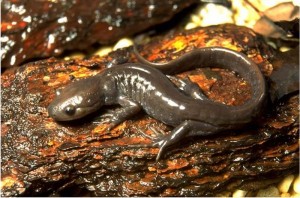 By Pepper Parr
By Pepper Parr
March 7th, 2023
BURLINGTON, ON
There was a time when signs of Spring were evident when the upper part of King Road was shut down so that the Jefferson Salamaner could cross the road and do things that the boy salamanders do to the girl salamanders.

Does the Jefferson Salamander have enough status to justify creating a holiday to celebrate its existence.
Times have changed and Burlington has to cope with copulating coyotes.
“It’s Coyote Denning Season: said the city announcement. “– Five things Burlington residents can do to deter coyotes”
It’s that time of the year again when the City of Burlington is reminding residents about steps they can take to help reduce the risk of potential coyote conflicts during their denning season.
Denning season is the time of year when coyotes’ pups are born. Shortly before a coyote gives birth, between April and May, the coyote will begin digging a den which they will use to raise their pups.
While naturally wary of humans, coyotes will seek food and shelter in residential neighbourhoods when they are being fed on purpose or by accident.
The Top 5 things residents can do to help deter coyotes include:

Does the city have plans to destroy the dens when they discover where they are?
1. Never feed coyotes
Feeding coyotes, on purpose or by accident, teaches them to depend on human handouts and can cause them to become too familiar with humans. This familiarization can lead to aggressive behaviour around people and dogs.
2. Never leave pets unattended
Coyotes may see pets as a threat to their territory and may attack, especially when there is a den site nearby. Always keep dogs on a short leash (less than six feet long) when walking outdoors. Make sure your cats and dogs are not left alone outside, even in your fenced backyard.
3. Keep a tidy property
Residential neighbourhoods are an ideal coyote habitat with access to water, shelter and food sources like garbage, pet food, fruit tress and birdfeeders. Make sure your property is tidy and clear of garbage, food, brush, long grass and wood piles which are ideal den sites for coyotes or other wild animals that attract coyotes.
4. Inspect your property
Make sure spaces around and under decks, sheds and similar structures are closed off with wire screening that extends at least 20 centimetres under the ground.
5. Consistently haze coyotes
Discouraging coyotes takes vigilance. Ongoing efforts by the entire community to haze coyotes can help to re-instill their fear of humans and stop unwelcome behaviour.
Use one or more of these hazing techniques every time you see a coyote to help move it out of a residential area:
• Stop. Don’t run.
• Pick up small children and pets.
• Yell loudly;
• Wave your arms and make yourself look as big as possible;
• Use air horns, whistles, bang pots;
• Throw small rocks, large sticks, cans and/or rubber balls near the coyote;
• Spray the coyote with water from a garden hose or a water gun filled with vinegar.
• Back away slowly.
Report coyote sightings, including aggressive, sick or injured coyotes online at www.burlington.ca/coyote. Call 9-1-1- if a coyote poses an immediate threat or danger to public safety.

Nick Anastasopoulos, Director of Building & Bylaw getting his point across at a Council meeting
Nick Anastasopoulos, Director of Building & Bylaw, did not expect to see coyote management on his job description when he came to Burlington. He is now a bit of an expert and has this to say: ““With spring around the corner, we’d like to remind residents about steps we can all take to help prevent potential coyote conflicts. Research and past experiences have shown the most effective thing we can do to lower direct run ins with coyotes is to remove coyote enticements such as food – this includes direct feeding, such as leaving food outdoors for coyotes, and indirect feeding, like leaving waste garbage out at the curb overnight or rotting fruit on the ground from fruit trees.”
Quick Facts
• Coyotes are native to North America and can be found living in urban and rural areas.
• Food sources like mice, rats and garbage are readily available in urban areas, attracting coyotes to residential neighbourhoods.
• In 2015, Burlington City Council approved a Coyote Response Strategy that provides guidelines on preventing and managing conflicts with coyotes.
• Concerns about direct or indirect feeding of wildlife can be reported to Animal Control at animalshelter.mailbox@burlington.ca
• Hand feeding and ground feeding wildlife on private or public property is prohibited by the City’s Lot Maintenance Bylaw (59-2018) and is subject to a $300 fine.
• To request an audit of your yard for coyote attractants by city Animal Control staff, please email animalshelter.mailbox@burlington.ca.
Links and Resources
• Learn more about living with coyotes at www.burlington.ca/coyote
• Report a coyote sighting online at www.burlington.ca/coyote



















Does the same rules apply to lycra lout cyclists who try and run me down on the sidewalk?
One major difference ,our Mayor does not have Salamanders hunted and killed like coyotes
The coyotes are everywhere, and didn’t in fact magically disappear after the election (as the city’s and council’s interest in them seemed to). Many of us have long given up on reporting injured or sick-looking coyotes or any coyotes to the City because we have discovered we get nowhere. Instead we lament the fact that we can’t keep our pets safe in our own fenced backyards, and walking our dogs is now stressful as we continually are watching for coyotes. I’ve had several encounters, all of them scary.